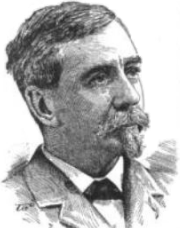R. Bruce Ricketts facts for kids
Quick facts for kids
R. Bruce Ricketts
|
|
|---|---|
 |
|
| Born |
Robert Bruce Ricketts
April 29, 1839 Orangeville, Pennsylvania
|
| Died | November 13, 1918 (aged 79) Ganoga Lake, Pennsylvania
|
| Occupation | Merchant, farmer, military officer |
| Spouse(s) |
Elizabeth Reynolds
(m. 1868) |
| Children |
|
| Signature | |
Robert Bruce Ricketts (born April 29, 1839 – died November 13, 1918) was an important American soldier. He was an artillery officer during the American Civil War. He is most famous for leading his group of cannons, called a battery, to defend Cemetery Hill during the Battle of Gettysburg. This brave action happened on the second day of the battle.
Contents
Early Life and Education
Robert Bruce Ricketts was born on April 29, 1839, in Orangeville, Pennsylvania. His father, Elijah Ricketts, was a merchant and farmer. Robert was one of nine children.
He went to school at the Wyoming Seminary near Wilkes-Barre, Pennsylvania. Before the war started, he was studying law. He was also thinking about going to college.
Joining the Civil War
In 1861, the First Pennsylvania Light Artillery was formed. This group was also known as the 43rd Regiment Pennsylvania Volunteers. Robert Bruce Ricketts joined the army on July 8, 1861.
About a month later, he became a first lieutenant in Battery F. This battery was a part of the First Pennsylvania Light Artillery. The regiment was split up, and different batteries served with different parts of the Union Army.
Battery F first fought in the Battle of Dranesville on December 20, 1861. Later, Ricketts' group helped defend Hancock, Maryland. This was against an attack by Confederate General Stonewall Jackson.
Fighting in Key Battles
Battery F joined the Army of Virginia in March 1862. Under Ricketts' leadership, they went on a mission to gather information near Warrenton, Virginia.
The battery then took part in the campaign that led to the Second Battle of Bull Run. They fought bravely at the Battle of Cedar Mountain on August 8. They helped cover the retreat of another Union corps.
Battery F also helped defend Henry House Hill at Second Bull Run. They were present at the Battle of Chantilly. They also saw intense fighting at the Battle of Antietam. Ricketts became a captain on March 14, 1863.
Hero at Gettysburg
Ricketts' battery arrived at Gettysburg on the morning of July 2, 1863. They took up a position on East Cemetery Hill. This spot was dangerous because it was open to enemy fire from different directions.
Around nightfall, Confederate soldiers attacked the hill. They broke through the Union lines in some places. Some Confederates even reached the top of the hill. One group attacked Ricketts' battery, trying to capture their cannons.
The fight became hand-to-hand, but the Confederates could not take all the cannons. Union reinforcements arrived and drove the Confederates back down the hill. A monument now stands where Ricketts' battery fought so bravely.
After Gettysburg
After the Battle of Gettysburg, Ricketts' battery was moved to the II Corps artillery. They fought in the Bristoe Campaign. At the Second Battle of Auburn, they helped cover a retreat.
At the Battle of Bristoe Station, Ricketts' battery quickly moved into position. Their firing helped defeat a Confederate attack. For their bravery, they were given the honor of presenting captured Confederate cannons to General George Meade.
Ricketts' battery continued to fight with the II Corps in the Overland Campaign. At the Battle of the Wilderness, a part of his battery was captured but then quickly taken back. General George Getty praised Ricketts for his "great coolness and courage" during this fight.
Ricketts also supported attacks at the Battle of Spotsylvania Court House and the Battle of North Anna. His battery then crossed the James River and participated in the Second Battle of Petersburg. His cannons fired some of the first Union shots into the city.
During the long Siege of Petersburg, Ricketts was promoted. He became a major in August 1864. In 1865, he was promoted again to the rank of colonel. He continued to play an important role in the Union Army's artillery.
Life After the War
After the Civil War, Ricketts became a successful businessman. He, his father, and an uncle started buying large amounts of timber land. By 1873, they owned about 66,000 acres (267 square kilometers).
In 1872, Ricketts and his partners opened a saw mill. He used his own lumber to build the North Mountain House at Ganoga Lake. This house was a hotel for guests until 1903. After that, it became his family's summer home.
Ricketts married Elizabeth Reynolds on October 1, 1868. They had three children: William Reynolds, Jean Holberton, and Frances Leigh. Two lakes, Lake Jean and Lake Leigh, are named after his daughters.
Robert Bruce Ricketts passed away on November 14, 1918, at Ganoga Lake. At the time of his death, he still owned about 80,000 acres (324 square kilometers) of land. This land included Ganoga Lake and Lake Jean.
His family later sold much of this land to the state of Pennsylvania. This land became the main part of what is now Ricketts Glen State Park.

